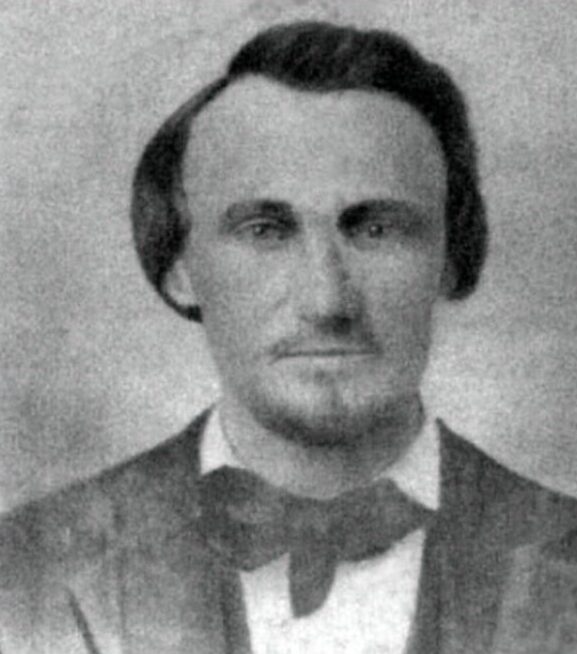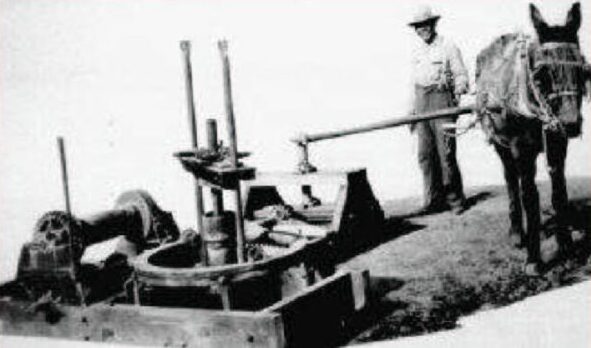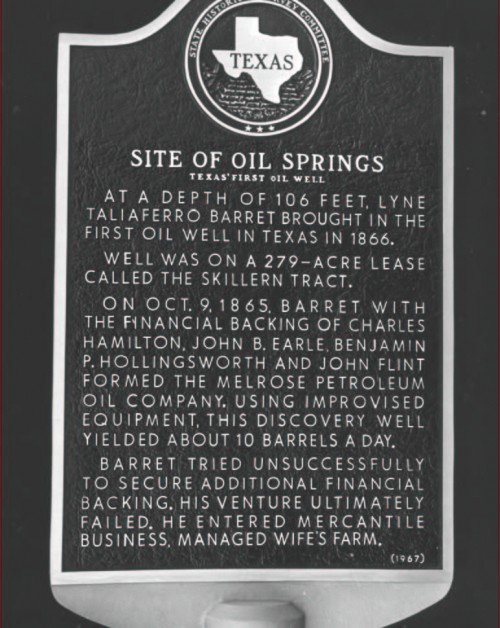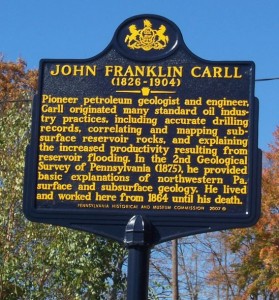Well at Nacogdoches produced 10 barrels of oil a day in 1866.
Lyne Taliaferro Barret completed the first Texas oil well on September 12, 1866, west of the Sabine River. His Nacogdoches County discovery well did not produce commercial quantities of oil; it lay dormant for nearly two decades until others returned to Barret’s oilfield.
In December 1859, less than four months after Edwin L. Drake’s first U.S. oil well drilled in Pennsylvania, a similarly determined petroleum explorer named Lyne (Lynis) Taliaferro Barret began searching in an East Texas area known as Oil Springs.

Lyne T. Barret leased land just east of Nacogdoches, an area known for its oil seeps. Detail from Texas & New Orleans Railroad map (1860) courtesy David Rumsey Historical Map Collection.
The 1848 invention of kerosene, popularly called “coal oil,” had prompted demand for an illuminating lamp fuel made from oil, inspiring speculation and drilling.
First Lone Star State Oil Discovery — Native Americans had long known of the eastern Texas natural seeps. Early settlers used oil for its purported medicinal benefit for both themselves and their livestock.
Lyne Barret’s interest in finding the newly prized resource was no doubt prompted by its lucrative selling price of $20 per barrel. He joined the chase for petroleum riches but prudently continued to operate his successful mercantile partnership in Melrose.
On December 15, 1859, Barret leased 279 acres near Oil Springs, about 13 miles southeast of Nacogdoches, from Lucy W. Skillern. He began drilling. Before he could find oil, the Civil War and Texas’ secession from the Union forced him to postpone his search.
Boring for Texas Oil
During the war years, as the nation struggled to survive, the impact on the young oil business was dramatic. Wild fluctuations in oil prices were common. In 1859 oil sold for $20 a barrel; in 1861 it averaged only 52 cents a barrel. Two years later, oil averaged $8.15 a barrel. In these early years, such fluctuations posed a great risk for those who sought their fortunes drilling for oil.
As the Civil War continued, Barret served as a captain in the Confederate States of America’s Quartermaster Corps in Texas’ Nacogdoches district. The war ended in 1865 at Appomattox Court House, Va., not far from where Barret had been born in 1832.

Although Lyne Taliaferro Barret (1832-1913) received little acclaim during his lifetime, in 1966 a memorial marker was dedicated at his grave in Melrose Cemetery and in 1981 a second marker was placed at his home south of Nacogdoches.
After the war, Nacogdoches County was occupied by Union forces from the Fifth Military District and was spared much of the lawlessness that plagued other East Texas counties during the difficult post-war period of Reconstruction. Barret rejoined his partner, Blackstone Hardeman Jr., formerly of Company K, First Texas Infantry Regiment.
The two Confederate veterans restocked the shelves of Hardeman & Barret General Merchandise Store with goods brought by wagon from New Orleans since railroad service was virtually nonexistent in Texas after the Civil War.
Melrose Petroleum Oil Company
Barret’s quest for oil returned quickly as he secured another drilling contract with the heirs of Lucy Skillern on October 9, 1865. By December, he had joined with Benjamin P. Hollingsworth, Charles Hamilton, John Flint, and John B. Earle to form the Melrose Petroleum Oil Company.
To drill the well, the company decided to use an auger fastened to a pipe and rotated by a steam-driven cogwheel (see Making Hole — Drilling technology). On June 9, 1866, Barret contracted with Benjamin T. Kavanaugh for the use of “Butler’s Improved Auger for Boring Wells.”
The drilling contract included $50 for the purchase of “two augers, one eight and a half inches in diameter or thereabouts, and the other six and a half inches in diameter or thereabouts, with a coupling for the set for connecting the augers with the stem or poles for boring.”

Instead of traditional cable tool percussion drilling, Barret chose to use an auger fastened to a pipe and rotated by a steam-driven cogwheel — the basic principle of rotary drilling — which has been used ever since.
The contract guaranteed that “the augers hereby sold shall well and truly perform the work of boring through earth boring (sic), but not through hard or solid rock. Should they fail to do so, he agrees to furnish other good ones or take them back and refund the money.”
Throughout the summer of 1866, the Melrose Petroleum Oil Company continued drilling and on September 12, 1866, Lyne Barret’s tenacity was rewarded. At a depth of 106 feet, the “No. 1 Isaac C. Skillern” struck oil.
The first commercially producing oil well in Texas yielded a modest 10 barrels of oil per day. Samples were forwarded to the Department of Emigration in New York, which pronounced the oil “superior in all its properties.”

Oil Springs is on Farm Road 226 southeast of Nacogdoches. Native Americans once used oil seepage in the area for medicinal purposes.
Despite his oil well’s modest production, Barret traveled to New York and Pennsylvania to invest in additional equipment.
New Science of Petroleum Geology
The future of the U.S. petroleum industry would leap forward when Barret met John F. Carll, the man who almost single-handedly invented both petroleum geology and petroleum engineering.
“Many geological historians consider Carll’s third report published in 1880 his magnum opus and one of the most remarkable books on early petroleum geology and engineering ever written,” noted a 2007 article, John F. Carll: The First Petroleum Geologist and Engineer (see Rocky Beginnings of Petroleum Geology).
Carll agreed to run tests and assist in development of the Skillern lease with financial backing from Brown Brothers of Titusville, Pennsylvania, and on March 1, 1867, the agreement was signed.
Dramatic swings in the price of oil remained hazardous to oil men and speculators everywhere. Local production often exceeded demand, and when railroads and pipelines could not move all the crude being produced, storage tanks filled quickly and prices dropped precipitously.

The 1848 Barret homestead was added to the National Register of Historic Places in 1979.
When the price of oil dropped to only $2.40 a barrel, Brown Brothers determined that the low price and political unrest caused by Reconstruction made further development of Barret’s find “unfeasible” and withdrew their financial backing. Impatient investors wanted to sell their interest in the company – but turned down Barret’s offers of land and demanded cash.
Despite encouragement by the highly respected Carll in 1868, when oil prices went up again, the field was never developed. Barret suffered extensive financial loss and was forced to give up on the oil business and return to his general store in Melrose, ending his wildcatter dreams of oil wealth.
Lyne Barret’s failed project lay dormant for nearly two decades until 1887 when new wildcat drilling companies once again found oil and by 1889 had forty producing wells. Even so, in 1890 the wells produced only 54 barrels of oil valued at $227.

Pennsylvania historical marker at Pleasantville commemorates subsurface mapping pioneer John Franklin Carll, petroleum geologist and engineer.
The first Texas oil boom arrived in June 1894 when the Corsicana oilfield was discovered by a drilling contractor hired by the city to find water. The Nacogdoches oilfield remained the first and oldest in Texas and as late as 1941 still recorded production of eight barrels a day from 40 wells. Some of these wells produced into the 1950s.
Barret’s 1867 discovery was a modest beginning for Texas’ oil business, which would become the leading U.S. oil-producing state in America. A century later, the Texas State Historical Survey Committee placed a marker on the site of the No. 1 Isaac C. Skillern, a dozen miles southeast of Nacogdoches (just off Farm Road 226). As a marker dedicated in 1966 at Barret’s grave noted:
“Born in Virginia. Came with parents to Texas, 1842. Married Angelina Thomas. Had 9 children. Drilled the first oil well in Texas, 1866. If efforts to drill early in 1859 had succeeded, he would have completed first oil well in the United States. Low demand and scarce capital halted his oil operations. He spent rest of his life as a farmer and community leader.”
_______________________
Recommended Reading: Nacogdoches, Images of America (2009); Early Texas Oil: A Photographic History, 1866-1936
(2000); Trek of the Oil Finders: A History of Exploration for Petroleum (1975); The Birth of the Oil Industry (1936). Your Amazon purchase benefits the American Oil & Gas Historical Society. As an Amazon Associate, AOGHS earns a commission from qualifying purchases.
_______________________
The American Oil & Gas Historical Society (AOGHS) preserves U.S. petroleum history. Please become an AOGHS annual supporter and help maintain this energy education website and expand historical research. For more information, contact bawells@aoghs.org. Copyright © 2024 Bruce A. Wells. All rights reserved.
Citation Information – Article Title: “First Lone Star Discovery.” Authors: B.A. Wells and K.L. Wells. Website Name: American Oil & Gas Historical Society. URL: https://aoghs.org/petroleum-pioneers/first-texas-oil-well. Last Updated: September 5, 2024. Original Published Date: December 1, 2004.



